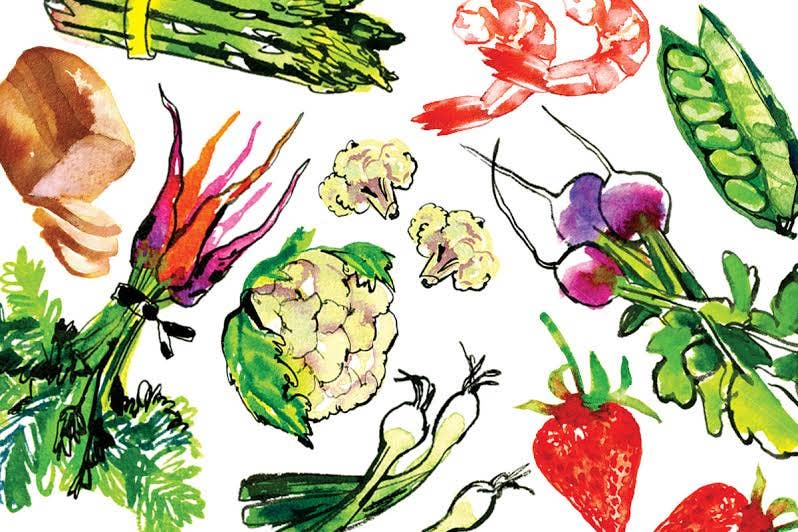
A Year’s Bounty
Sustainable-farming advocates Jeanne-Marie Herman and her husband, Michael Ableman, author of the book Fields of Plenty, among others (see SAVEUR's June/July 2006 issue), know from years of experience that a well-designed kitchen is a matter as much of necessity as of aesthetic choice. When they moved in 2000 from Southern California to a Victorian farmhouse on six acres of land on Saltspring Island, across the Strait of Georgia from Vancouver, British Columbia, they were determined to live almost exclusively on food raised and produced on or near their small farm. "I've made a commitment that everything I serve will be as organic and as local as possible," says Jeanne-Marie, who does nearly all of the cooking, preserving, drying, and canning that sustains the family through the year.
The couple's level of dedication to eating local requires hard work and plenty of careful planning, as well as a kitchen that can accommodate all manner of food preparation. Jeanne-Marie's busiest time is the late summer, when produce arrives from the surrounding fields by the bushel. Stone fruits, like apricots and Italian plums, are dried in an electric food dehydrator, after which they're left in storage until winter. The majority of the harvest, however, goes into the bright sauces and jams that Jeanne-Marie puts up in glass jars. In the fall, apple and pear sauces and quince chutneys join the larder; squash and root vegetables are kept in the cool, dark pantry. By late October there's enough food stored to last the couple, their four-year-old son, Benjamin, and Michael's son Aaron, age 25, through the following spring.
The kitchen's centerpiece is a three-and-a-half-foot-long island, which a friend made out of acacia and maple wood salvaged from the farm the couple owned back in California. The island, though beautiful, is ultimately utilitarian: casters allow it to be moved around easily, and its surface is a single, broad chopping block that has an opening at one end so that stems, peels, and other detritus can be swept directly into the compost bucket that sits in a compartment below. The remainder of the space underneath the chopping block could be used for storage, but Jeanne-Marie has instead given it over to Benjamin, who sometimes plays there when she cooks. Other essential components of the kitchen are a capacious sink and a wide, four-burner 1950s O'Keefe & Merritt stove, with an accompanying industrial ventilation hood. "I need to be able to put two or three 20-quart pots on at once," says Jeanne-Marie. While pragmatism reigns in the family's kitchen, Jeanne-Marie was determined not to sacrifice aesthetics: the room's cherry cabinets and river-slate countertops harmonize with the warm furnishings of the rest of the house.
If any meal showcases the fruits of the family's labors, it's their annual Christmas dinner. This year, butternut squash roasts in the oven while Jeanne-Marie mashes potatoes with garlic and then sautes chard, all grown on the couple's farm. The houska (braided bread) and kolacky (fruit-filled pastries) she's baked for the occasion are longstanding favorites she learned to make from her Czech paternal grandmother. The turkey wasn't raised on the farm, but it didn't come from far away: Jeanne-Marie bought it from a woman who runs the local post office and raises poultry on the side. And the dried mushrooms in the wild rice stuffing are from neighbors who foraged them in the woods nearby. Even as she relishes this special meal, ever practical Jeanne-Marie confesses she's already imagining what she's going to do with the stock she'll make tomorrow from the leftover turkey.
Utilitarian Chic For making applesauce, Jeanne-Marie uses a gadget called the Peel Away, which peels, cores, and slices an apple in only five seconds. Its retro look complements the kitchen's vintage and reclaimed fixtures perfectly.
Sweet Rewards In a variation on her grandmother's recipe for prune-filled kolacky, Jeanne-Marie fills pastries with a rich, tangy paste made from apricots collected on friends' farms and dried earlier in the year.
Tabletop Traditions Jeanne-Marie has collected vintage china for years, but for holiday meals she uses dishes and silverware inherited from her grandmothers. "It's a time to remember my family and the things they brought to my life," she says.
Keep Reading
Continue to Next Story










